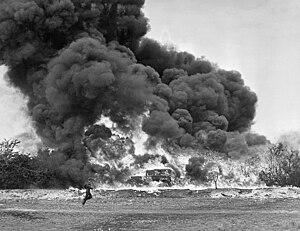| Flame fougasse | |
|---|---|
 A demonstration of 'Fougasse', somewhere in Britain. A car is surrounded in flames and a huge cloud of smoke. c 1940. | |
| Type | Anti-personnel and anti-tank mine |
| Place of origin | United Kingdom |
| Service history | |
| In service | 1940–present |
| Used by | British Army and Home Guard |
| Wars | Second World War |
| Production history | |
| Designer | Petroleum Warfare Department and William Howard Livens |
| Designed | 1940-41 |
| No. built | 50,000 in Britain |
| Specifications | |
| Rate of fire | Single shot |
| Effective firing range | 30 yd (27 m)[1] |
| Sights | None |
A flame fougasse (sometimes contracted to fougasse and may be spelled foo gas[2]) is a type of mine or improvised explosive device which uses an explosive charge to project burning liquid onto a target.[3] The flame fougasse was developed by the Petroleum Warfare Department in Britain as an anti-tank weapon during the invasion crisis of 1940. During that period, about 50,000 flame fougasse barrels were deployed in some 7,000 batteries, mostly in southern England and a little later at 2,000 sites in Scotland.[4] Although never used in combat in Britain, the design saw action later in Greece.[4]
Later in World War II, Germany and Russia developed flame throwing mines that worked on a somewhat different principle. After World War II, flame fougasses similar to the original British design have been used in several conflicts including the Korean and Vietnam Wars where it was improvised from easily available parts.[5] The flame fougasse remains in army field manuals as a battlefield expedient to the present day.[5]
- ^ Barrel Flame Traps 1942, p. 6.
- ^ "Dictionary". Vietnam. Retrieved 13 October 2010.
- ^ Dear & Foot 2001, p. 296.
- ^ a b Banks 1946, p. 38.
- ^ a b FM 20-33. Combat Flame Operations.